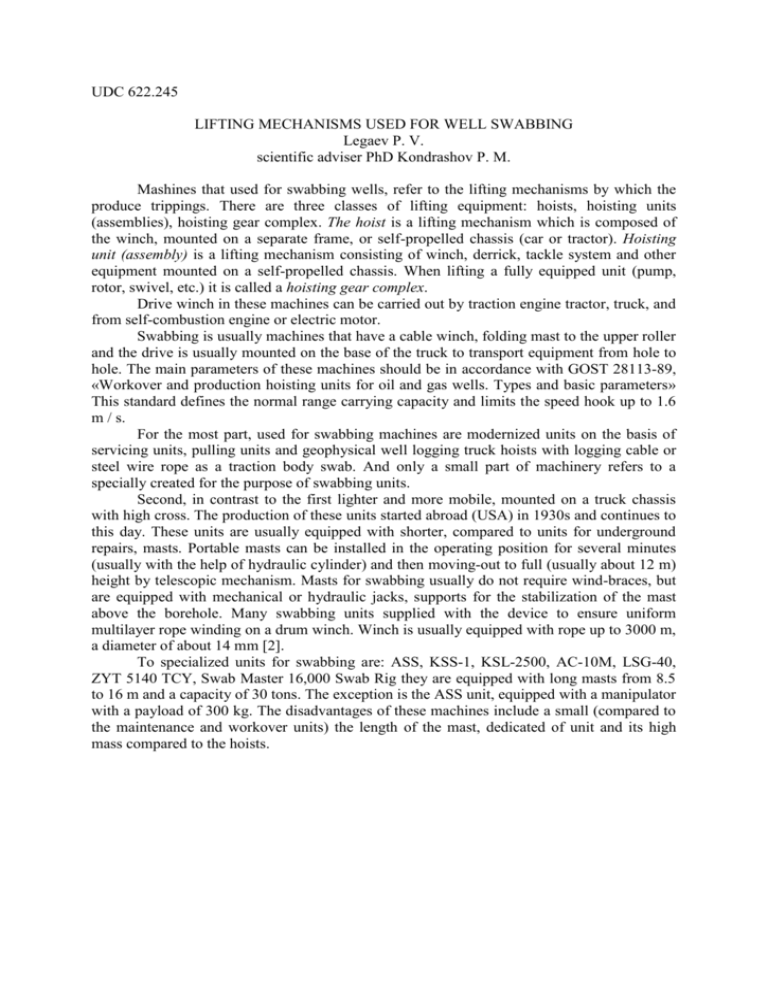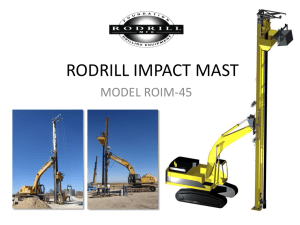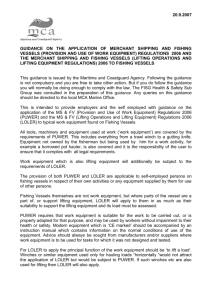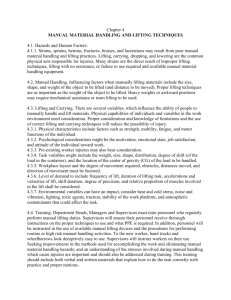UDC 622.245 LIFTING MECHANISMS USED FOR WELL
advertisement

UDC 622.245 LIFTING MECHANISMS USED FOR WELL SWABBING Legaev P. V. scientific adviser PhD Kondrashov P. M. Mashines that used for swabbing wells, refer to the lifting mechanisms by which the produce trippings. There are three classes of lifting equipment: hoists, hoisting units (assemblies), hoisting gear complex. The hoist is a lifting mechanism which is composed of the winch, mounted on a separate frame, or self-propelled chassis (car or tractor). Hoisting unit (assembly) is a lifting mechanism consisting of winch, derrick, tackle system and other equipment mounted on a self-propelled chassis. When lifting a fully equipped unit (pump, rotor, swivel, etc.) it is called a hoisting gear complex. Drive winch in these machines can be carried out by traction engine tractor, truck, and from self-combustion engine or electric motor. Swabbing is usually machines that have a cable winch, folding mast to the upper roller and the drive is usually mounted on the base of the truck to transport equipment from hole to hole. The main parameters of these machines should be in accordance with GOST 28113-89, «Workover and production hoisting units for oil and gas wells. Types and basic parameters» This standard defines the normal range carrying capacity and limits the speed hook up to 1.6 m / s. For the most part, used for swabbing machines are modernized units on the basis of servicing units, pulling units and geophysical well logging truck hoists with logging cable or steel wire rope as a traction body swab. And only a small part of machinery refers to a specially created for the purpose of swabbing units. Second, in contrast to the first lighter and more mobile, mounted on a truck chassis with high cross. The production of these units started abroad (USA) in 1930s and continues to this day. These units are usually equipped with shorter, compared to units for underground repairs, masts. Portable masts can be installed in the operating position for several minutes (usually with the help of hydraulic cylinder) and then moving-out to full (usually about 12 m) height by telescopic mechanism. Masts for swabbing usually do not require wind-braces, but are equipped with mechanical or hydraulic jacks, supports for the stabilization of the mast above the borehole. Many swabbing units supplied with the device to ensure uniform multilayer rope winding on a drum winch. Winch is usually equipped with rope up to 3000 m, a diameter of about 14 mm [2]. To specialized units for swabbing are: ASS, KSS-1, KSL-2500, AC-10M, LSG-40, ZYT 5140 TCY, Swab Master 16,000 Swab Rig they are equipped with long masts from 8.5 to 16 m and a capacity of 30 tons. The exception is the ASS unit, equipped with a manipulator with a payload of 300 kg. The disadvantages of these machines include a small (compared to the maintenance and workover units) the length of the mast, dedicated of unit and its high mass compared to the hoists. Fig. 1. Classification of lifting mechanisms used for well swabbing Fig. 2. Hoisting unit KSS-1 in transport position: 1 - frame 2 - reducer, 3 - tape reel, 4 - main winch motor, 5 - transfer case with power pumps, 6 - electric motor, 7 - tank 8 - hydraulic filters, 9 - mast, 10 - pulley, 11 - mast cylinder, 12 - auxiliary winch drum 13 - auxiliary winch motor, 14 - pulleys, 15 - cab operator, 16 - container for goods and swabs, 17 - outriggers, 18 – stage for control head, 19 wellhead equipment; 20 - collecting tank leaks; 21 - operating area, 22 - heat exchanger, 23 electric power unit, 24 - ladder For servicing units and pulling units include: AZINMASH-37A (37A1, 37, 40), UP-50 (60, 80), UPT-32, APRS-32 (40, 50), A2-32 (32K), A4-32 A5-40 (40M), A-50M, they set the mast length of 14 - 22.4 m and a capacity of 32 to 80 tons. The disadvantages of these machines is the fact that they are usually equipped with two-section telescopic mast, which are sensitive to shock, falls and have low maintainability, and weight setting themselves higher than that of specialized units for swabbing. Fig. 3. Hoisting unit AZINMASH-37 in the transport position: 1 - block and tackle arrangement, 2 – tower, 3 - power transmission, 4 - front support, 5 operator's cabin, 6 – winch, 7 - hydrocylinder lift towers, 8 - back support Go to the hoists, used for swabbing include: AS-10, AZINMASH-43P, LPT-8, LPR-60, LT11KM, and geophysical well logging truck hoists: PKS-5, PKS-5G-04M, MPZ-PKS-SWAB, the difference consisting in the fact that the logging cable uses as a traction part. They are devoid of the disadvantages of the hoist units. They are smaller, lighter and have a simple device due to lack their own masts. A separate kind of hoists are not self-propelled hoists, "the frame" or "skid". They are: PKN, DynaWinch SS2-400, DynaWinch LS2-400, etc. Fig. 4. Hoist LPT-8: 1 – frame, 2 - fuel tank, 3 - air cylinders, 4 - compressor, 5 - control panel, 6 - winch, 7 driveshaft, 8 - cantilever frame, 9 - transmission, 10 – safety reel, 11 - drive mechanism rotor, 12 - removable ladder, 13 - hinged screw-emphasis Fig. 5. Well logging truck hoist PKS-5: 1 - chassis "Ural-375A", 2 - body, 3 - remote winch operators; 4 – pulling-and-running unit, 5 - a guide block, 6 - rotary unit, 7 - power grid, 8 - logging loads, 9 - fold; 10 - understudy pedal clutch control, 11 - gear selector, 12 - handle corrector of cable, 13 - hand brake drum, 14 - gear lever, 15 - a fire extinguisher, 16 - spare tire References: 1. Mordvinov A. A Exploration wells: Study Guide - Ukhta: USTU, 2004. - 107 p., Ill. 2. Valovsky V. M., Technique and technology swabbing wells. - Moscow: JSC "VNIIOENG", 2003. - 396 p.







